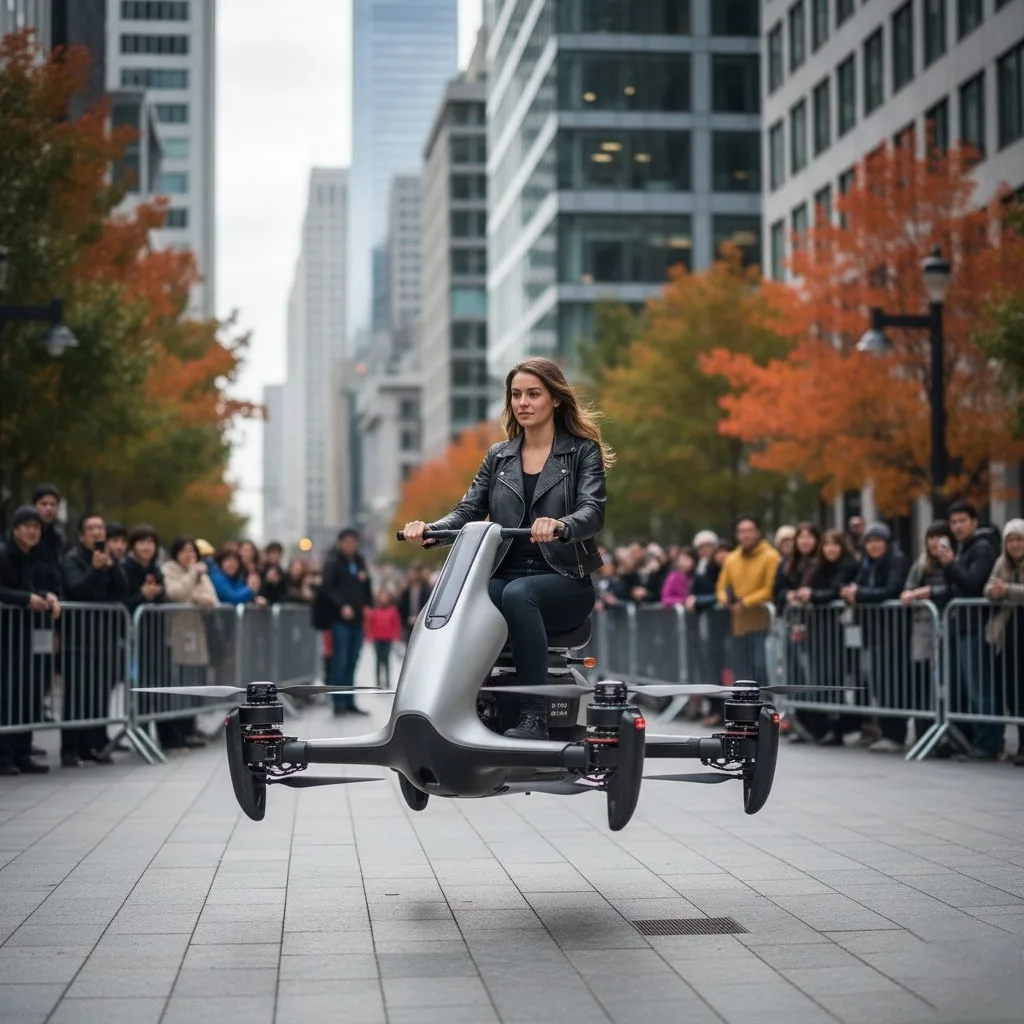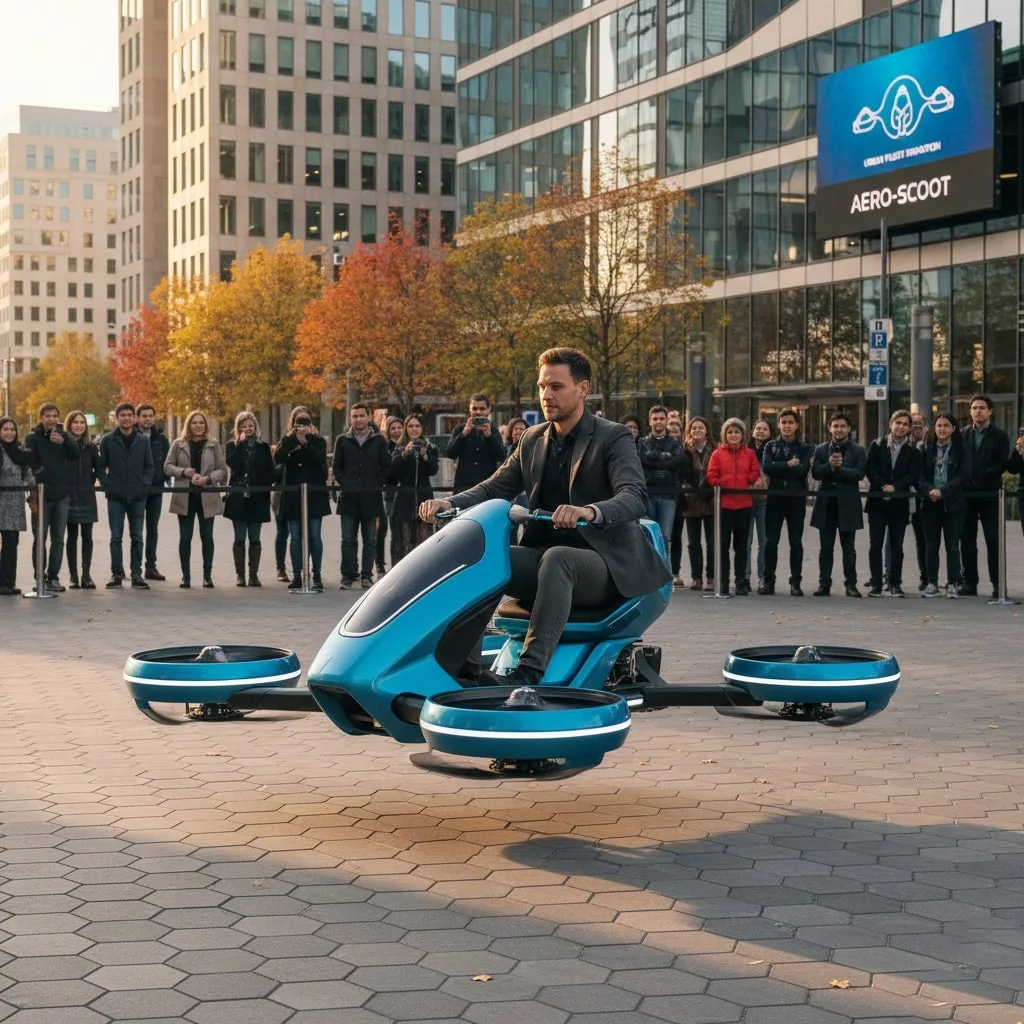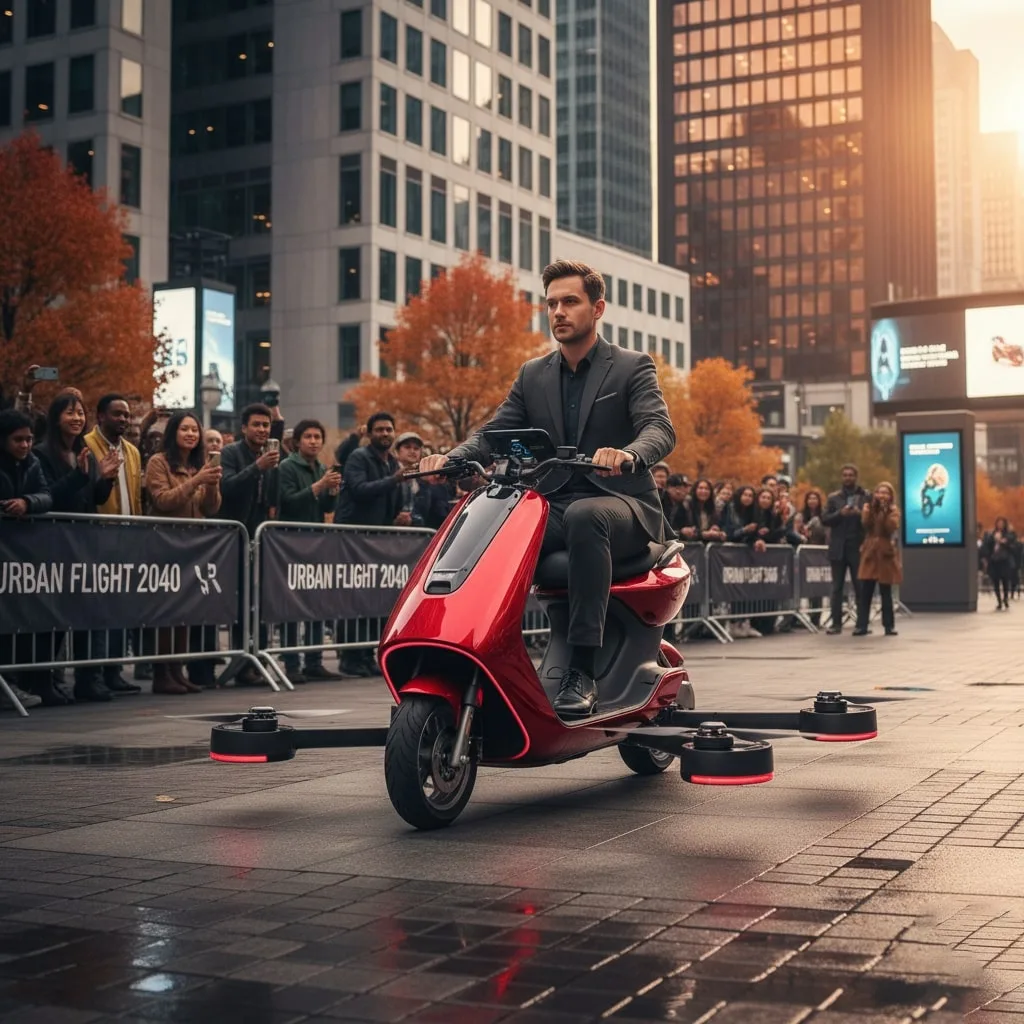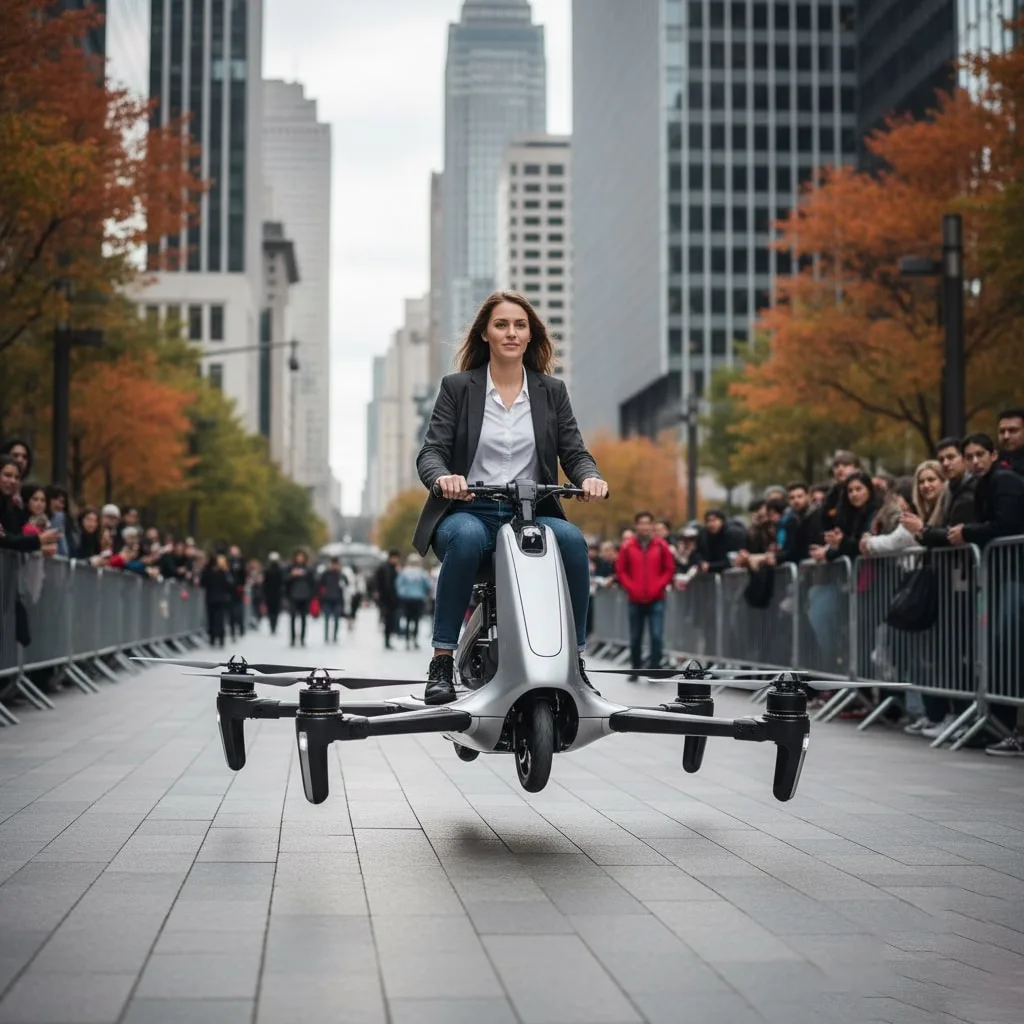The way we think about personal transportation is undergoing a dramatic transformation. While electric scooters have already revolutionized urban mobility, a new category of vehicles is emerging that takes this concept to an entirely new dimension. Scooter drones represent the next frontier in personal transportation, combining the convenience of electric scooters with the freedom of aerial flight. These innovative machines are no longer just science fiction fantasies but are becoming tangible products that could reshape how we navigate our cities.
Understanding What Scooter Drones Actually Are

Scooter drones are hybrid vehicles that merge the design principles of electric scooters with drone propulsion technology. Unlike traditional scooters that remain grounded, these vehicles use multiple rotors or propellers to lift riders off the ground, allowing them to travel through three-dimensional space. The concept draws inspiration from both the simplicity of kick scooters and the sophisticated engineering of quadcopters and larger drone systems.
These vehicles typically feature a standing platform similar to conventional electric scooters, but instead of wheels making contact with pavement, they rely on powerful electric motors driving multiple propellers. The rider stands on the platform and uses handlebars for balance and steering, much like operating a regular scooter. However, the experience diverges significantly once the vehicle lifts off the ground, offering a mode of transportation that bypasses traffic congestion and terrain obstacles entirely.
The development of scooter drones has been made possible by advances in several key technologies. Battery technology has improved dramatically, providing the energy density needed to lift both the vehicle and rider. Brushless electric motors have become more powerful and efficient while remaining lightweight. Flight control systems borrowed from the drone industry have matured to the point where they can stabilize a human rider safely. All these elements combine to make personal aerial vehicles a realistic proposition rather than a distant dream.
The Technology Powering These Aerial Vehicles

At the heart of every scooter drone lies a sophisticated flight control system. These systems use multiple sensors including gyroscopes, accelerometers, barometers, and GPS receivers to constantly monitor the vehicle’s position, orientation, and movement. Advanced algorithms process this data hundreds of times per second, making tiny adjustments to motor speeds to keep the vehicle stable and responsive to pilot inputs.
The propulsion systems on scooter drones typically employ anywhere from four to eight or more rotors arranged around the platform. This redundancy serves two purposes: it provides the necessary thrust to lift the combined weight of vehicle and rider, and it offers safety through backup capability if one motor fails. The rotors themselves are carefully designed to maximize efficiency, often featuring carbon fiber construction to minimize weight while maintaining structural integrity.
Battery systems represent both the enabling technology and the primary limitation of scooter drones. Current lithium polymer and lithium ion batteries can provide enough power for flight times ranging from ten to thirty minutes depending on the vehicle’s design and the rider’s weight. Manufacturers are constantly working to extend this flight time, as longer battery life directly translates to greater practical utility. Fast charging capabilities are also becoming standard, allowing users to recharge their vehicles in under an hour.
The materials used in constructing scooter drones must balance strength with weight considerations. Carbon fiber composites, aerospace grade aluminum, and advanced polymers are common choices. Every component is scrutinized for weight savings because in aerial vehicles, every extra gram reduces flight time and performance. This obsessive attention to weight optimization is borrowed directly from the aerospace industry and applied to personal transportation.
Real World Applications and Use Cases

Urban commuters represent one of the most promising markets for scooter drones. Imagine leaving your apartment, stepping onto your personal aerial vehicle, and flying directly to your office building’s rooftop landing pad. You bypass street level traffic entirely, turning a frustrating hour long commute into a breezy fifteen minute flight. While regulatory frameworks are still catching up to this vision, the technology to make it happen already exists.
Emergency response scenarios offer another compelling application. First responders equipped with scooter drones could reach accident scenes much faster by traveling in straight lines over obstacles. Medical supplies could be delivered to remote or difficult to access locations. Search and rescue operations could deploy personnel more quickly across challenging terrain. The ability to move freely in three dimensions provides tactical advantages that ground based vehicles simply cannot match.
Recreation and tourism industries are already exploring how scooter drones might create new experiences. Imagine guided aerial tours over scenic landscapes, with groups of riders following an instructor through carefully planned routes. Adventure sports enthusiasts are particularly excited about the possibilities, seeing scooter drones as the next evolution beyond activities like paragliding or zip lining.
Industrial and commercial facilities with large campuses are testing scooter drones for internal transportation. Moving between buildings or across sprawling factory floors becomes much faster when you can simply fly over instead of walking or driving. Security personnel could patrol more effectively with aerial mobility. The applications in controlled environments like these may actually see adoption before broader public use becomes common.
Safety Considerations and Regulatory Landscape

Safety is paramount when discussing any form of human flight, and scooter drones are no exception. Multiple redundant systems are standard in well designed vehicles. If one motor fails, the others can compensate to allow for a controlled landing. Advanced models include ballistic parachutes that can deploy in emergencies, lowering the vehicle and rider safely to the ground. Collision avoidance systems using lidar and cameras help prevent mid air accidents.
Pilot training represents a significant consideration. Operating a scooter drone requires skills beyond those needed for ground based vehicles. Riders must develop three dimensional spatial awareness and learn to handle wind conditions, altitude changes, and emergency procedures. Many manufacturers are developing comprehensive training programs, often using simulators before progressing to actual flight under instructor supervision.
The regulatory environment for scooter drones remains a work in progress in most jurisdictions. Aviation authorities worldwide are grappling with how to integrate these personal aerial vehicles into existing airspace management systems. Questions about licensing requirements, altitude restrictions, designated flight corridors, and insurance obligations are still being answered. Some countries are moving faster than others in creating frameworks that balance innovation with public safety.
Noise pollution is another factor that must be addressed. Multiple spinning propellers create distinctive buzzing sounds that some find disruptive. Engineers are working on quieter rotor designs and noise dampening technologies. Finding the right balance between performance and acoustic impact will be crucial for public acceptance, especially in residential areas.
The Current State of the Market

Several companies have emerged as pioneers in the scooter drone space. Some are well funded startups with backing from venture capital firms eager to invest in future transportation. Others are established drone manufacturers extending their product lines into personal mobility. A few traditional vehicle manufacturers are also exploring this space, not wanting to miss out on what could be a transformative new category.
Prototype demonstrations and limited production models have already taken flight. Videos of early adopters hovering above the ground and performing basic maneuvers have gone viral on social media, generating both excitement and skepticism. Trade shows and technology conferences regularly feature the latest designs, with each iteration showing improvements in flight time, stability, and user friendliness.
Pricing for scooter drones remains prohibitively expensive for most consumers. Current models aimed at early adopters carry price tags ranging from tens of thousands to over one hundred thousand dollars. These costs reflect both the sophisticated technology involved and the relatively small production volumes. As manufacturing scales up and technology matures, prices are expected to decrease significantly, though they will likely remain more expensive than conventional electric scooters for the foreseeable future.
The path to widespread adoption involves overcoming numerous hurdles beyond just technology and regulation. Infrastructure needs to be developed, including charging stations and landing pads. Insurance products must be created to cover this new category of vehicle. Public perception needs to shift from viewing personal flight as dangerous or frivolous to seeing it as a practical transportation option.
Environmental Impact and Sustainability

Electric propulsion means scooter drones produce zero direct emissions during operation, offering environmental advantages over gasoline powered vehicles. When charged using renewable energy sources, their carbon footprint becomes even smaller. This aligns with broader trends toward sustainable transportation solutions in response to climate change concerns.
However, the full environmental picture requires considering manufacturing impacts and battery lifecycle issues. Producing lithium batteries involves mining operations with environmental consequences. End of life battery disposal and recycling remain ongoing challenges. Responsible manufacturers are working to minimize these impacts through sustainable sourcing practices and developing better recycling programs.
Energy efficiency comparisons between scooter drones and other transportation modes reveal interesting tradeoffs. While electric cars are generally more energy efficient per passenger mile for longer distances, scooter drones can be competitive for short urban trips when their ability to travel in straight lines is factored in. The environmental equation also includes reduced road infrastructure needs, as aerial vehicles do not require pavement maintenance.
Noise and wildlife impacts deserve consideration as well. If scooter drones become common, their collective sound could affect both human communities and animal habitats. Flight paths might need to avoid sensitive ecological areas. These concerns mirror ongoing discussions about commercial drone deliveries and urban air mobility concepts more broadly.
Looking Toward Tomorrow’s Transportation Landscape

The future of scooter drones likely involves progressive integration into transportation ecosystems rather than overnight revolution. Early adoption will probably occur in controlled environments like private campuses, resorts, or specially designated zones. As technology proves itself and regulations mature, usage could expand to urban environments with designated aerial corridors and automated traffic management systems.
Autonomous flight capabilities represent the next frontier. Just as self driving cars are being developed, scooter drones could eventually fly themselves with minimal pilot input. Users might simply specify a destination, and the vehicle would handle navigation, obstacle avoidance, and landing automatically. This could dramatically lower the skill barrier for operation while improving safety through consistent, computer controlled flight.
Integration with other transportation modes could create seamless multimodal journeys. Imagine using a scooter drone for the aerial portion of your commute, then folding it up to carry onto public transit for the remainder of your trip. Apps could plan optimal routes combining walking, flying, and mass transit based on real time conditions. Personal aerial vehicles become one option within a diverse transportation toolkit.
The social implications of widely available scooter drones extend beyond mere convenience. Access to three dimensional mobility could reshape urban planning and architecture. Buildings might be designed with rooftop access as a primary entry point. Cities could reclaim ground level space currently devoted to roads and parking. Social equity questions also arise about ensuring this technology benefits everyone rather than becoming a privilege only for the wealthy.
Wrapping Up the Future of Personal Flight
Scooter drones represent far more than just an interesting gadget or novelty toy. They embody humanity’s long standing dream of personal flight made practical through modern technology. While significant challenges remain before they become commonplace, the trajectory is clear. Advances in batteries, motors, materials, and flight control systems continue to make these vehicles more capable and accessible with each passing year.
The convergence of necessity and innovation drives this technology forward. Urban congestion worsens in cities worldwide, creating demand for transportation alternatives that can bypass ground level gridlock. Climate concerns push development toward zero emission solutions. Meanwhile, technological breakthroughs continue making personal aerial vehicles safer, more efficient, and more affordable.
Whether scooter drones become as ubiquitous as smartphones or remain a specialized transportation option for specific use cases remains to be seen. What seems certain is that they will play some role in the future mobility landscape. The companies, engineers, regulators, and early adopters working in this space today are literally building the future of how humanity moves through its environment. For anyone interested in transportation, technology, or glimpsing what tomorrow might bring, scooter drones offer a fascinating window into possibilities that once existed only in imagination but are now taking flight in reality.

